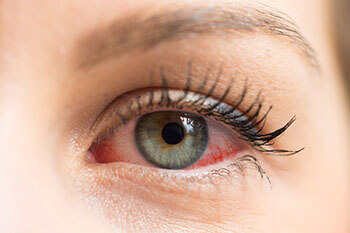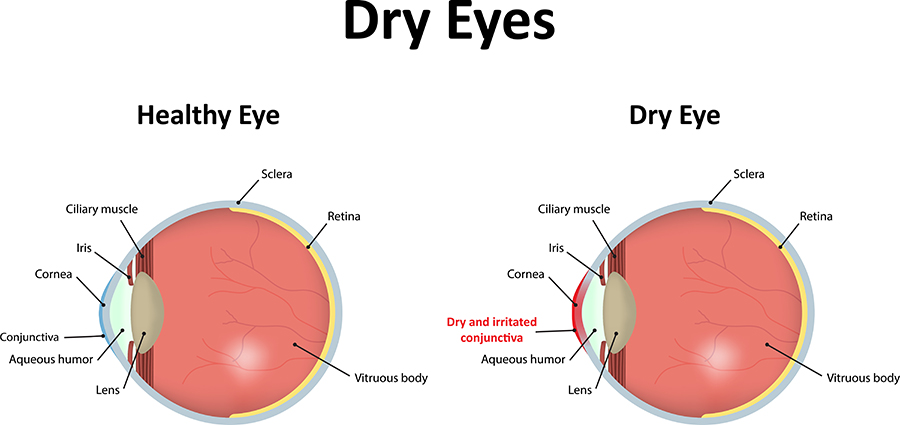Dry Eye, or Dry Eye Syndrome (DES), is a condition that affects millions of people. It is often a normal part of the aging process and is, therefore, more commonly seen in older people. Women and contact lens users also tend to suffer from dry eye. Other factors contributing to symptomatic dry eye include exposure to environmental irritants, dry climate, and certain health conditions, such as diabetes, thyroid deficiencies, and autoimmune disorders, such as Sjogren’s Syndrome, Rheumatoid Arthritis, Lupus, or Myasthenia Gravis. The use of certain medications can also be very drying to the eyes. Some of the most common medications are antihistamines, decongestants, blood pressure medications, antidepressants, and anti-anxiety medications.
Dry eye syndrome is the eye’s inability to lubricate and tear correctly. Oddly, many people who have dry eye syndrome actually tear excessively as the eye tries to overcompensate for the lack of tear film with too much reflexive tearing.
Most Common Symptoms of Dry Eyes

- Eye Redness
- Itchiness or Burning
- Sand or Grit feeling
- Blurred Vision or Fatigue
- Tearing or Watering
- Contact Lens Intolerance
- Sensitivity to Light
Complications of Dry Eye Syndrome
It is important to diagnose and treat dry eye syndrome in a timely fashion to prevent long-term complications, such as corneal scarring and thinning, corneal infections, and loss of the ability to tolerate contact lenses.

Dry Eye Tips
- Avoid cigarette smoke
- Sleep with a cool-mist humidifier
- Take Omega 3 supplements which are anti-inflammatory and promote a better quality tear film
- Wear wrap-around sunglasses on windy days
- Avoid drops that “get the red out”
- Get sufficient sleep
- Avoid positioning your head of your bed in the direct path of heater, fan or air conditioning vent
- Position computer screen lower than eye level
- Take contact lens holidays
- Remove all makeup thoroughly at the end of day
- Take breaks when using a computer and remember to actively blink
The Dry Eye Treatment Center at Metro Eye Care has the most innovative, cutting edge diagnostic tools and treatment methods. The dry eye consultation will assess the causes of dry eye and review pharmaceutical and integrative medicine treatment options.
Dry Eye Treatment Options
Artificial Tears, Gels, and Ointments
Artificial tears, gels, and ointments vary in their viscosity; some are the consistency of water, while others are thicker, or more viscous. Patients should begin by using drops two to four times each day. The gels are thicker than drops and, therefore, stay on the ocular surface longer. They can temporarily blur vision, though, so they are best used at bedtime. Artificial tears should be preservative-free if they are being used more than four times a day.
Anti-inflammatory Treatments
The underlying problem with dry eye is often chronic inflammation to the ocular surface. Anti-inflammatory treatments can be effective in preventing long-term damage to the tear-producing glands and, consequently, the cornea.
Xiidra and Restasis are eye drops that are used twice a day to treat dry eye by suppressing inflammation and increasing the quantity and quality of tear production.
Corticosteroid Eye Drops are steroids that are usually used as an initial pulse treatment to quiet inflammation. They are tapered off after several weeks of use.
Doxycycline is a medication that, used in low dosages, acts as anti-inflammatory treatment and is frequently used to treat dry eye, blepharitis, rosacea, styes, and other surface diseases.
Punctal Plugs
Punctal Plugs are tiny, comfortable silicone inserts that are easily placed in the tear duct to block tear drainage from the ocular surface. This instantly increases the quantity of tears, thereby increasing moisture and relieving dry eye. This is an in-office procedure in which a plug is inserted into the small openings in the nasal aspect of the eyelids.
MiBoThermoflo
MiBoThermoflo is thermal treatment technology for dry eye syndrome. It applies continuous controlled heat to the outside of the eyelids using a gel for a warm gentle massage. The heat is absorbed deep into oil glands to break down hardened and crystallized oils that prevent the flow of tear film oil. After treatment with MiBoThermoflo, the oil glands will secrete a thinner and clearer oil which will provide a healthier, more effective tear film. This painless treatment is done right in the office with no down-time or side effects. The recommended treatment protocol is three sessions over the course of a month.
Autologous Serum Eye Drops
Autologous Serum Eye Drops are special eye drops that are custom-made, taking advantage of all the natural growth factors, immunoglobulins, vitamins, and other essential components that are present in the patient’s own blood. The patient’s blood is drawn and spun down using a centrifuge. The plasma-rich liquid is made into customized eye drops, which promotes the health and healing of the ocular surface.
Amniotic Membrane
Amniotic Membrane is a biological therapeutic corneal bandage used to heal and treat dry eye. The natural therapeutic actions of the amniotic membrane reduce inflammation and scarring, promoting, and expediting healing. The membrane is placed on the eye for several days. Upon removal, the eye is resurfaced, rejuvenated, and feels better.
TrueTear Neurostimulator
TrueTear is a device that uses state-of-the-art technology called neurostimulation to help increase tear production. This is a drop-free, drug-free dry eye treatment option that uses nasal stimulation with tiny, random pulses of energy sending nerve signals to the brain. The brain then sends nerve signals to the tear glands surrounding the eyes to increase tear production for a safe, effective way to treat dry eye.
